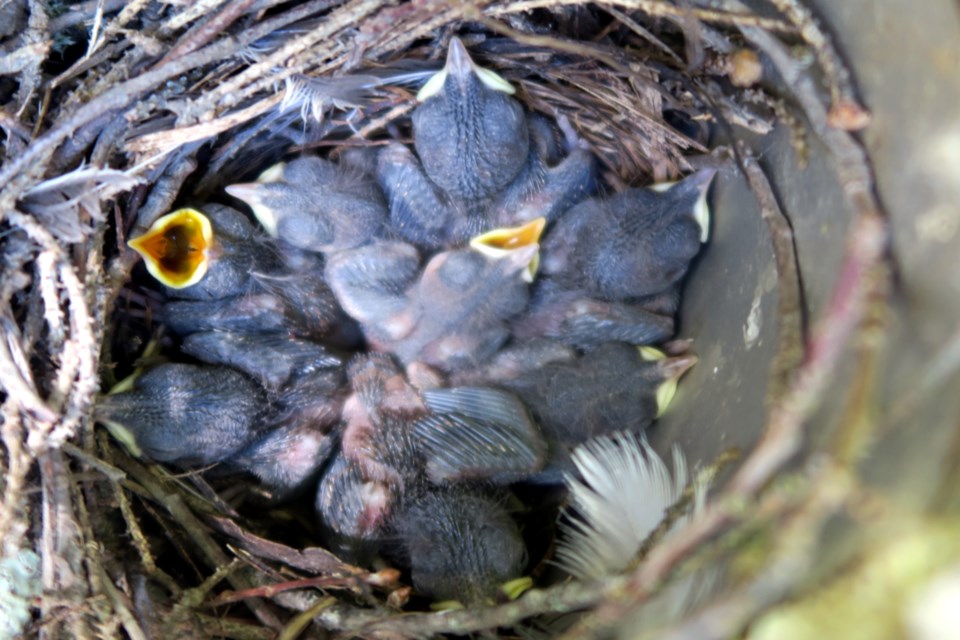ATHABASCA, BOYLE — Canaries used to used as an early warning system for dangerous gases in coal mines - if the bird died there was too much carbon dioxide and in nature it is also the birds, like the house wren or the mountain bluebird, that warn of fluctuating environmental conditions.
Two local naturalists and conservationists are promoting the virtues of bird boxes to encourage nesting – Albert Karvonen has been watching house wrens nest in pre-Telus “coffee can” bird boxes on underground cable markers near Amisk Lake, east of Boyle, and Arnie Gerlach has long had a passion for the mountain bluebird, placing hundreds of his own boxes throughout the Tawatinaw Valley.
“Getting people involved in nature is helping to mitigate climate change,” said Karvonen. “Climate change is a serious thing and so I thought, 'Can wrens help mitigate climate change?' And my answer is yes, indirectly they can. They need forests and if we don’t have forests – what produces oxygen? Trees.”
Both birds eat spiders, grasshoppers, flies and a host of other insects so as their populations dwindle, insect populations increase.
“Now we look at them more as part of the ecosystem,” he said. “And they feed almost entirely on insects.”
Deforestation impacts all birds who rely on trees for both a place to build a nest and to find material for the nest. Mountain bluebirds prefer fewer trees, but they are in danger as well, said Gerlach.
“A few years ago, I saw a (Westlock County) guy spraying (the ditches) and I was checking a nest box and he came closer and closer so I walked across the road to my truck to let him go by and right in front of my eyes he squirted the nest box with that chemical,” he said. “Just imagine, I think some of it went in the entrance hole. I phoned right away and I got the same old dance, ‘Oh no, no, our chemical is just fine.’”
He noted in 2019 he and volunteers checking nests found 94 dead nestlings – more than they banded that day and recently he noticed a bluebird laid pure white eggs instead of the usual blue. The female abandoned the nest, the eggs didn’t hatch and Gerlach said the surrounding vegetation was black from being sprayed.
“Somebody sent me an e-mail the other day about it,” said Gerlach. “He checked into what they were using and it was a kind of a chemical that made them blind; if they got in contact with it at all the birds would be blind.”
While Gerlach places bird boxes, Karvonen is hoping Telus brings back the practice of allowing nesting in the underground cable markers, adding he contacted the company, but the person on the phone didn’t seem interested in his suggestion.
“The first ones were just metal cans to signal the buried cable and then somebody suggested to, at that time AGT (Alberta Government Telephones), 'Why don't you make those into bird boxes?' So they put two holes on these cans one about an inch and a half size ... and the other one inch; one to attract wrens, and the other one might attract some others like bluebirds and so on,” said Karvonen.
He laughed noting wrens will make a nest anywhere they find convenient though, like in the binder box on a baler or other surprise places.
“My brother had a pair of coveralls in the shed,” said Karvonen. “He went to put his coveralls on and there was a wren’s nest in the pocket – over two years in the big pocket – because they were hanging; wrens are very ingenious that way.”
Karvonen calls wrens ‘community birds’ meaning they are common in many rural communities even if some people don’t realize they’re hearing them sing.
“It's a very small bird, but boy they’re very aggressive and they're very fast and they're always chattering,” he said. “Small, inconspicuous, but very vocal for its size; it’s continuously calling especially when they’re incubating and then the chicks come.”
But as common as wrens seem bird populations across North America are in decline – a 2019 study estimated over three billion birds since 1970 – so it becomes increasingly important to preserve the populations.
“In 2016, we fledged over 1,800 little ones and that's been going down steadily,” said Gerlach. “This year it'll only be maybe 25 per cent of that.”
Gerlach added weather, cats and introduced species like the English sparrow and European starling, both of which are aggressive birds, are impacting bird populations.
“We had 242 breeding pairs in 2008 and when the storm was over, we only had 85 or something,” he said. “But we built them back. It took 10 years to get up there again and now look what’s happened. Maybe somebody’s out there saying, ‘Hey, bluebirds are strong enough’ but they’re not, they’re still rare birds.”
The men hope younger generations will step in to help out. Gerlach says he can always use more volunteers to monitor the hundreds of boxes and Karvonen has been teaching about conservation for many years both as an educator and a documentary film maker.
“I think it’s a way to get citizens, young people, involved,” said Karvonen.



